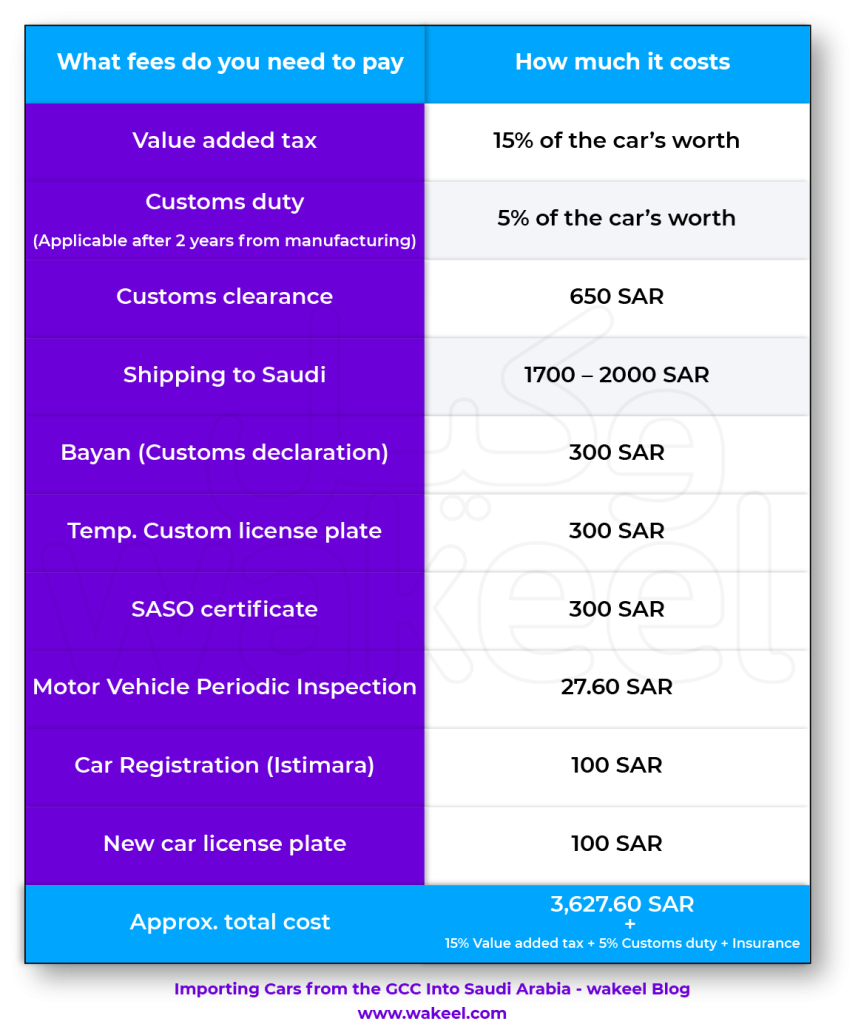
Importing Cars from the GCC Into Saudi Arabia
Whether you’ve found your next car for half the price in the UAE or you’re moving from a GCC country to KSA, there are many reasons you might want to import a car into Saudi Arabia. Whichever is the case, bringing a car to Saudi can be much cheaper than buying one here! Plus, you can even maximize your savings if you know where to find the best car insurance deal in Saudi.
We’ve put together a helpful guide covering everything you need to know on importing cars to Saudi Arabia from a GCC country. It’s a process that will be new to most people, so it’s useful to have some info on the requirements, steps, and fees.
Step 1: know the requirements for importing cars to Saudi Arabia
Before you even think about importing a car to Saudi, you need to check the 3 main requirements.
- Car must be within 5 years of its manufacturing date (Check the year on your car’s registration.)
- Car must meet GCC specifications. (if you’re not sure about it, check the car’s VIN SASO website.)
- Car must meet Saudi fuel efficiency standards. (Check this on SASO’s website too.)
Plus, the car shouldn’t be on ZATCA’s ban list 👇

Step 2: Get the paperwork sorted for the car
With your car in transit to Saudi, it’s time to prepare what you need to clear customs, and then register the car. For this, you’ll need to have the following documents in place:
Documents required
- Proof of car ownership (export certificate for GCC countries, or equivalent).
- ID /visa (Iqama), and driver’s license.
- Original car invoice, showing ownership and value.
- Authorization for a customs broker, if you’re not importing the car on your own.
Step 3: Collect your imported car in Saudi
Once the imported car arrives in Saudi, it goes through the clearance process. The clearance happens at entry points like Al Batha border King Fahad border, or Jeddah depending on your location in Saudi.
- When the authorities approve the car after inspection, you will pay 20% of the car’s worth in Saudi — 15% for VAT plus 5% for customs.
- For some cars, they must be sent to SASO’s inspection unit to check if they meet environmental and safety regulations in Saudi.
- Before clearing the car, you also need to pay 300 riyals to issue car plates with a customs card. This temporary number plate gives you 15 days to legally register your car in Saudi.
Step 4: Find insurance for your imported car
- Before the 15-day deadline ends, you have to buy car insurance.
- Car insurance is mandatory in Saudi, but you can choose between comprehensive or TPL. Use online car insurance comparison websites in Saudi to see how much insurance for imported cars could cost.
Step 5: Register your car & get Istimara
Once find the best car insurance for you in Saudi, the next step is to get it register the car in Saudi.
- Use The General Department of Traffic in Saudi Arabia provides an e-service to issue your vehicle license “Istimara” without having to visit the departments.
- After that you can finally replace the temporary customs number plate with the permanent Saudi number plate.
The cost of importing a car to Saudi
Now let’s answer the important question — How much does it cost to import a car to Saudi Arabia? It varies depending on all kinds of factors, including how much you have to pay for shipping, VAT, customs duties, and customs clearance broker.

After reading this guide, you should have a better idea of the process of importing a car from the GCC to Saudi. This includes the documents you’ll need, what order to do things in, and how much it costs. You can always save more money if you import a car into Saudi by yourself, without the help of a customs broker, plus if you shop around to find affordable car insurance prices in Saudi Arabia!
